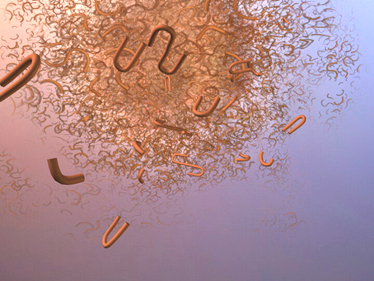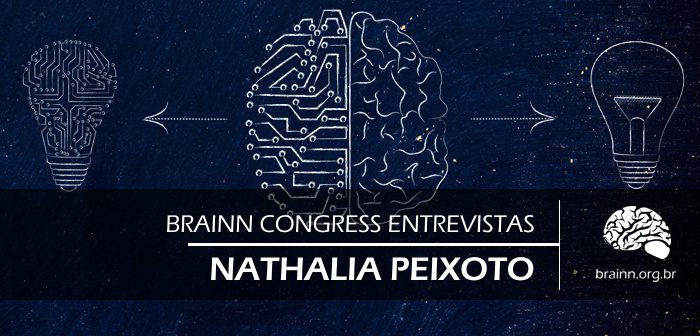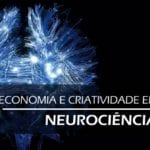Researcher Nathalia Peixoto of George Mason University reveals how interdisciplinarity helps develop innovative researches, including ‘biological robots’.
April 13th, 2017 By Ricardo Schinaider – Redação WebContent
Controlling robots using animal brains may seem like science fiction, but it was a topic that interested Nathalia Peixoto as early as graduation.
Nathalia studied Electrical Engineering, but her curiosity and fascination with other areas of knowledge led her to explore several laboratories at Unicamp, where she studied. From March 27 to 29, 2017, Nathalia returned to the University to participate as a guest speaker at the IV BRAINN Congress. In an interview for the RICD´s website, she told us a bit about her career and highlighted the fundamental role that interdisciplinarity has in Academics.
INTERDISCIPLINARITY IN THE CENTER OF STUDIES
“I did scientific initiations in Mathematics, Biology and even in Linguistics“, recalls the scientist. “I was interested in everything. I would take my bicycle and ride through all the institutes. And I believe that these experiences gave me a different view than that a person who, for example, did only scientific initiation in Electrical Engineering. ”
I was interested in everything. I would take my bicycle and ride through all the institutes.

Researcher Nathalia Peixoto, one of the invited scientists at the 4th BRAINN Congress
Among all the areas that she played with, Nathalia chose Biomedical Engineering to take her Master’s degree. The choice came not only from the desire to unite brains and machines, but also because “there are a lot of neurological problems still unsolved, and I thought that Electrical Engineering could help bring some clarity to many of them,” she recalls.
Learn more about the 4th BRAINN Congress
In her Master’s project, the researcher used engineering tools to study models of migraine. Thus, the interdisciplinarity that marked her graduation continued to accompany her career, both in the doctorate at USP and postdoctoral at Stanford, and today it continues to be present in her research laboratory at George Mason University, in the United States. The research lines addressed by the laboratory are varied, but always seek to find a link between electrical engineering and neuroscience.
“I develop projects with my students related to voice-controlled wheelchairs, measurement of neurotransmitters in the brain and study of addiction: how to form and whether it is possible to get rid of it by electrically stimulating the brain,” says Nathalia.
BRINGING THE ORGANIC TO THE ROBOTIC WORLD
The idea of controlling robots using brains – a concept that is always present in Nathalia’s curious mind – is the basis of one of her most interesting projects, which has gained increasing attention in the media.
The scientist and her research group work on the development of autonomous robots with biological components that can be used in high-risk situations for humans – such as in accidents involving radioactivity, chemical elements or the chance of an explosion.
“To develop this model, the first step is to extract a mouse´s brain and place it in a solution with adequate temperature to keep it active,” explains Nathalia. “Then we insert a part of the brain in a kind of computer chip, where we can stimulate it and measure the cell´s response.”
The first electrical stimulus applied to the brain is mild, and the reaction of the neurons is weak. The second electric stimulus is extremely strong. A few minutes after the strong stimulus, the weak stimulus is applied again. This time, however, the reaction of the neurons is quite different.

One of the advantages of this bioelectronic interface is that the robot would be completely autonomous, that is, it would not depend on the internet or GPS systems to work.
“The response is about 10 times more intense when compared to the first stimulus,” says Nathalia. “This shows that cells can remember a specific stimulus. We want to prove that we can use this ability of the brain to make it recognize and remember a number of patterns and eventually use it to control a robot. One of the advantages of this bioelectronic interface is that the robot would be completely autonomous, that is, it would not depend on the internet or GPS systems to function. ”
PROMOTING STUDIES ABOUT ALZHEIMER

Plaques are formed when pieces of beta-amyloid protein cluster. Small clusters can block signaling between cells at the synapses. They can also activate the cells of the immune system that cause inflammation and destroy deficient cells. Source: Alzheimer’s Association. Source: Alzheimer´s Association
The researcher points out that with only one mouse, it is possible to obtain 50 fractions of the brain and, consequently, to control 50 different robots. This procedure, which allows a large number of samples to be obtained from a single animal, is also attractive for research that seeks to test drugs against neurological and neurodegenerative diseases. Nathalia’s own group has already used this approach to evaluate, for example, the protective effects of turmeric in Alzheimer’s Disease.
The experiment consisted of adding beta-amyloid protein plaques (a characteristic of Alzheimer’s Disease) in the solution containing part of the brain of a mouse. In some solutions, turmeric has also been added. The result showed that brain cells from turmeric-containing solutions took longer to undergo the neurodegenerative effects of beta-amyloid plaques. The possible implications of this finding are enormous, specially for Alzheimer´s patients, and continue to be explored by the group.
NEW RESEARCH, NEW PARTNERSHIPS
For the future, the researcher intends to continue linking engineering and neuroscience for the development of new robots and the study of neurological diseases. In addition, she also wants to start collaborations with BRAINN. For Nathalia, the RICD has the ideal interdisciplinary environment for the development of projects in these areas.
“Here we see physicists talking to neuroscientists, neuroscientists talking to engineers, engineers talking to doctors and so on,” the scientist said.
“Therefore, I believe that BRAINN offers this opportunity for interdisciplinarity to bloom, something that today is critical for doing research,” concludes Nathalia.










 Português do Brasil
Português do Brasil